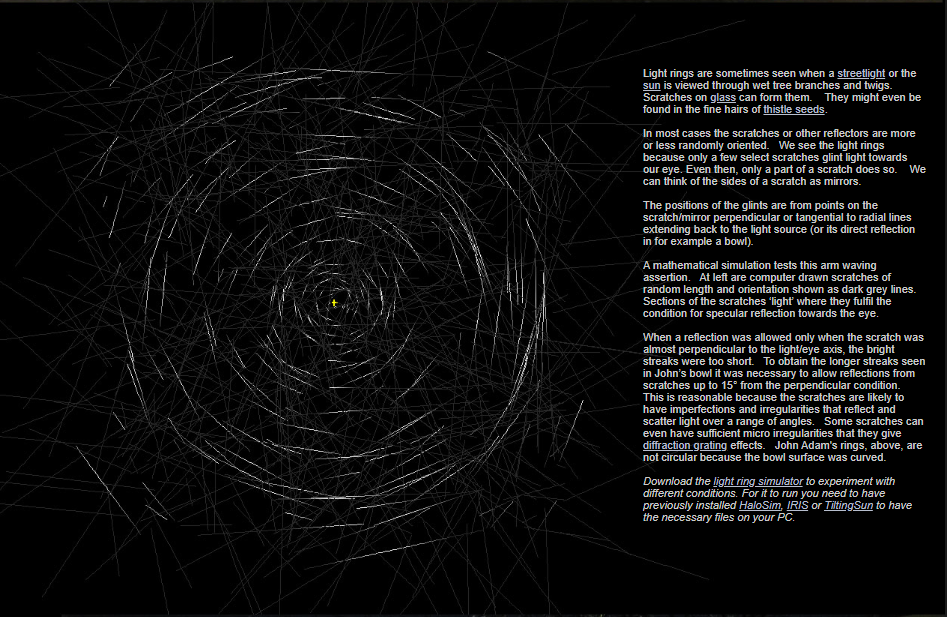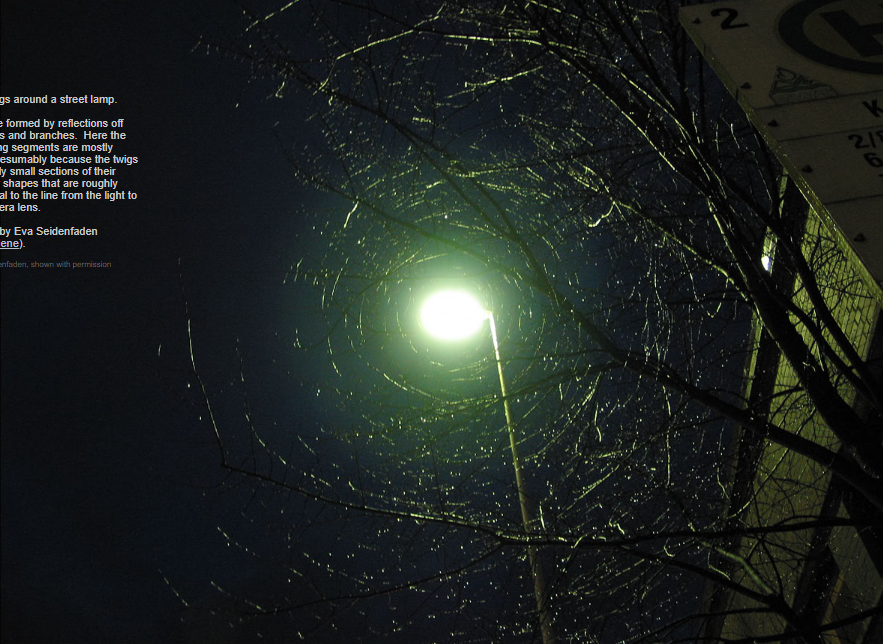OPOD - Kitchen Optics, Light Circles
OPOD - Kitchen Optics, Light Circles
Have you ever noticed intriguing light rings formed by scratches on reflective surfaces? Whether it's a stainless steel bowl, glass, or even the fine hairs of thistle seeds, these light rings can captivate our attention. But why do these rings form, and what causes them to appear in such distinctive patterns?
The Phenomenon of Light Rings
When light interacts with scratches or other reflectors on a surface, it can produce fascinating ring-shaped patterns. These light rings are often seen when a streetlight or the sun is viewed through wet tree branches and twigs, or even when scratches are present on glass surfaces. They can even manifest in the delicate hairs of thistle seeds. Despite the random orientation of these scratches or reflectors, the resulting glints of light form concentric circles around the light source.
Explaining the Formation of Light Rings
The appearance of light rings can be attributed to the selective reflection of light from specific scratches or reflectors. Only a few select scratches glint light towards our eyes, and even then, only a portion of each scratch contributes to the phenomenon. Imagine the sides of a scratch acting like mirrors, reflecting light towards us.
To understand the positions of these glints, we can consider the scratch as a mirror perpendicular or tangential to radial lines extending back to the light source or its direct reflection. In other words, the glints occur at points on the scratch that align with these radial lines. This concept can be visualized through a mathematical simulation that tests this assertion.
The Mathematics Behind Light Rings
In a simulated scenario, computer-generated scratches of random length and orientation are depicted as dark grey lines. The sections of these scratches that fulfill the condition for specular reflection towards the eye appear as bright streaks. The simulation reveals that when reflections occur only when the scratch is almost perpendicular to the light/eye axis, the resulting bright streaks are too short.
To obtain longer streaks, similar to those observed in real-life examples, reflections from scratches up to 15° from the perpendicular condition are necessary. This allowance is reasonable because scratches often possess imperfections and irregularities that scatter light over a range of angles. Some scratches may even have micro irregularities that create diffraction grating effects, further enhancing the complexity of the light rings. It's important to note that the shape of the surface on which the scratches are present can also influence the appearance of the rings.
Experimenting with Light Ring Simulation
If you're fascinated by the phenomenon of light rings, you can explore different conditions and observe their effects using a light ring simulator. This simulator allows you to experiment with various parameters and visualize how changes impact the formation of light rings. To run the simulator, you'll need to have previously installed software such as HaloSim, IRIS, or TiltingSun on your PC, as these provide the necessary files for the simulation.
Light Rings in Nature
While kitchen optics provide a convenient setting to observe light rings, these captivating phenomena also occur naturally in outdoor environments. One example is when light rings form around street lamps due to reflections off wet twigs and branches. In these instances, the bright ring segments are generally shorter, likely because only small sections of the irregular shapes of twigs are approximately tangential to the line connecting the light source and the camera lens.
The diversity of settings in which light rings can be observed highlights the ubiquity of this optical phenomenon. From kitchen bowls to outdoor landscapes, scratches and reflectors create mesmerizing patterns that evoke wonder and curiosity.

Kitchen Optics - Light Rings
John Adam (Mathematics in Nature) imaged these ringed glints from scratches on a stainless steel bowl. ©John Adam, shown with permission
Even though the bowl scratches are in all directions, their glints form rings around the two lamp reflections. Why?
We see similar light rings outdoors - lower image by Eva Seidenfaden (Paraselene).

Light rings are sometimes seen when a streetlight or the sun is viewed through wet tree branches and twigs. Scratches on glass can form them. They might even be found in the fine hairs of thistle seeds.
In most cases the scratches or other reflectors are more or less randomly oriented. We see the light rings because only a few select scratches glint light towards our eye. Even then, only a part of a scratch does so. We can think of the sides of a scratch as mirrors.
The positions of the glints are from points on the scratch/mirror perpendicular or tangential to radial lines extending back to the light source (or its direct reflection in for example a bowl).
A mathematical simulation tests this arm waving assertion. At left are computer drawn scratches of random length and orientation shown as dark grey lines. Sections of the scratches ‘light’ where they fulfil the condition for specular reflection towards the eye.
When a reflection was allowed only when the scratch was almost perpendicular to the light/eye axis, the bright streaks were too short. To obtain the longer streaks seen in John’s bowl it was necessary to allow reflections from scratches up to 15° from the perpendicular condition. This is reasonable because the scratches are likely to have imperfections and irregularities that reflect and scatter light over a range of angles. Some scratches can even have sufficient micro irregularities that they give diffraction grating effects. John Adam's rings, above, are not circular because the bowl surface was curved.
Download the light ring simulator to experiment with different conditions. For it to run you need to have previously installed HaloSim, IRIS or TiltingSun to have the necessary files on your PC.
Light rings around a street lamp.

Light rings around a street lamp.
They are formed by reflections off wet twigs and branches. Here the bright ring segments are mostly short, presumably because the twigs have only small sections of their irregular shapes that are roughly tangential to the line from the light to the camera lens.
Imaged by Eva Seidenfaden (Paraselene).
©Eva Seidenfaden, shown with permission
Note: this article has been automatically converted from the old site and may not appear as intended. You can find the original article here.
Reference Atmospheric Optics
If you use any of the definitions, information, or data presented on Atmospheric Optics, please copy the link or reference below to properly credit us as the reference source. Thank you!
-
<a href="https://atoptics.co.uk/blog/opod-kitchen-optics-light-circles/">OPOD - Kitchen Optics, Light Circles</a>
-
"OPOD - Kitchen Optics, Light Circles". Atmospheric Optics. Accessed on November 26, 2024. https://atoptics.co.uk/blog/opod-kitchen-optics-light-circles/.
-
"OPOD - Kitchen Optics, Light Circles". Atmospheric Optics, https://atoptics.co.uk/blog/opod-kitchen-optics-light-circles/. Accessed 26 November, 2024
-
OPOD - Kitchen Optics, Light Circles. Atmospheric Optics. Retrieved from https://atoptics.co.uk/blog/opod-kitchen-optics-light-circles/.